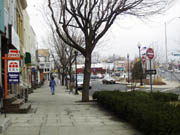Secaucus changed in stages, according to Dennis Pope, Ph.D., a Secaucus history buff and the former municipal court administrator. In some ways, Secaucus’ transformation in the 20th Century resembles those undergone by many so-called Third World Countries, moving straight from a culture based on farms and gardens to one of commercial enterprise, resulting in a kind of culture shock. Before 1950, Secaucus was a town of vegetable and hog farms, where people were intimately connected. Everyone knew everybody else. The society was self-contained, but not economically self-sufficient. “In the old days, people went to the city to work and shop,” Pope says. “They hopped on the old No.2 (bus) to Journal Square. Jersey City was a kind of downtown for Secaucus.” The stores in the Plaza section of Secaucus did provide a service to local residents, with a clothing store that sold baby items and work clothing, and a handful of other shops that formed the heart of Secaucus. Stores like Marra’s Drug Store and Bill’s Jewelers became institutions in town. The town was noted for its market gardens and numerous florists at the beginning of the century. In fact, before the turn of the century, the popular spot in town was Fred Lowry’s Hotel on Front Street between Golden Avenue and Humboldt Street. “A hundred years ago, the center of town was six or seven stores, mostly serving farmers,” said Sal Barone, owner of Family Video and the founding member of the Secaucus Plaza Business Association. “There were no cars. Most people traveled by horse and buggy. It was easy to get around. People didn’t commute. They worked or lived in town.” Some of the old-timers look back on those pre-World War II days as a kind of Tom Sawyer’s dream. Before the town built is swim center in 1977, people swam in the creek behind the high school. Before the ice rink was built, people waited for the Duck Pond to freeze over. “A person could be a Huck Finn here, build a raft and sail it on the river,” Pope said. While some people claim the town was a better place when the pigs had it, the town was largely looked down upon by more urban towns. “People here were hardworking, but they were stigmatized,” Pope said. “The town became synonymous with the odor of pig. Other people held their noses.” Secaucus had only a handful of sewers at the beginning of the century, something that also changed in the 1950s with the construction of the Koelle Boulevard Sewerage Treatment Plant. Dumps were another cause of odor and almost daily fires; the present site of Buchmuller Park was a dump. Secaucus didn’t have much in the way of services until after development began. Its original library was a room in Old Town Hall. The library currently in use was planned and constructed in the 1950s. The high school – although originally planned for the site now occupied by Clarendon School – wasn’t built until 1976. The town did not have a movie theater until Loews built in 1976 on Meadowlands Parkway. The Acme supermarket in the Plaza came in 1958. Before that, one small A&P served the entire town. Up until the end of World War II, life barely changed in Secaucus. But returning soldiers and the GI Bill meant a rise in single-family houses and the first rustle of change. The Turnpike, completed in 1952, cut right through the hog farms and brought traffic in from other parts of the state. “After World War II, life in Secaucus got better,” said Barone. “Route 3 went right through the center of town. Business was booming. We had plenty of parking. Businesses in the Plaza didn’t have to compete against outlets or the commercial malls. We did, however, have to have a lot of traffic cops.” The American dream brought people out of the cities like Hoboken and Jersey City during the 1950s and 1960s. These people came looking for suburbia. They transformed Secaucus into a residential community. Yet these days of glory of local business did not last long. In the early 1960s, the state redirected Route 3 as it constructed new bridges over the Hackensack River. “Merchants protested the change,” Barone said. “Old Route 3 became Route 153, closed off traffic to the center of town. Businesses on Front Street died. After that, the malls and outlets started to come into town.” In 1969, Secaucus changed again. The State of New Jersey established the Hackensack Meadowlands Development Commission in an effort to regulate how the meadows got developed. It was a change in attitude that said other communities in the state had an interest in how land in certain areas was used. Hartz Mountain was one of the first developers, purchasing 750 acres that they later turned into warehouses with their own network of streets. This development came in bits and pieces, sneaking up on the sleepy Secaucus community until “Old Secaucus” found itself surrounded by a new, vibrant commercial district, one that in the 1990s brought in as many as 40,000 additional people per day. But few of these 40,000 passed through the center of town, leaving local business in a life-and-death struggle. In 1990, a redesigned Plaza pushed the owners into action, when most of the parking spaces were removed. Since then, business owners have organized to win over loyalty of Secaucus customers, putting on everything from turkey giveaways over the holidays to rag-a-muffin parades. “We’re still trying to work things out,” Barone said, adding that he hopes the future will provide answers lacking in the past, like a solution to the constant problem of parking. “But we would like to make it possible for the center of Secaucus to thrive again, the way it did before the state moved Route 3.”
Secaucus changed in stages over 100 years
